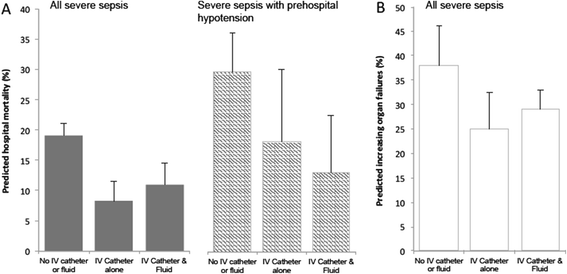Prehospital intravenous access and fluid resuscitation in severe sepsis: an observational cohort study
- PMID: 25260233
- PMCID: PMC4212132
- DOI: 10.1186/s13054-014-0533-x
Prehospital intravenous access and fluid resuscitation in severe sepsis: an observational cohort study
Abstract
Introduction: Prompt treatment of severe sepsis in the Emergency Department reduces deaths, but the role of prehospital fluid resuscitation is unknown. We sought to determine the risk-adjusted association between prehospital fluid administration and hospital mortality among emergency medical services (EMS) patients admitted with severe sepsis.
Methods: We performed a prospective, observational study of patients hospitalized with severe sepsis on admission among 45,394 adult EMS encounters taken to 15 hospitals from 11/2009 to 12/2010 by a two-tier EMS system in King County, Washington. The region mandated recording of prehospital intravenous catheter and fluid administration in prehospital records, along with detailed demographic, incident, physiologic, and hospital adjustment variables. We determined the effect of prehospital intravenous catheter or fluid versus no catheter or fluid on all-cause mortality using multivariable logistic regression.
Results: Of all encounters, 1,350 met criteria for severe sepsis on admission, of whom 205 (15%) died by hospital discharge, 312 (23%) received prehospital intravenous fluid, 90 (7%) received a prehospital catheter alone and 948 (70%) did not receive catheter or fluid. EMS administered a median prehospital fluid volume of 500 mL (interquartile range (IQR): 200, 1000 mL). In adjusted models, the administration of any prehospital fluid was associated with reduced hospital mortality (Odds ratio =0.46; 95% Confidence interval: 0.23, 0.88; P =0.02) compared to no prehospital fluid. The odds of hospital mortality were also lower among severe sepsis patients treated with prehospital intravenous catheter alone (Odds ratio =0.3; 95% Confidence interval: 0.17 to 0.57; P <0.01).
Conclusions: In a population-based study, the administration of prehospital fluid and placement of intravenous access were associated with decreased odds of hospital mortality compared with no prehospital catheter or fluid.
Figures


Comment in
-
Prehospital treatment of sepsis: what really makes the "golden hour" golden?Crit Care. 2014 Dec 17;18(6):697. doi: 10.1186/s13054-014-0697-4. Crit Care. 2014. PMID: 25673254 Free PMC article.
References
-
- Huang DT, Angus DC, Barnato A, Gunn SR, Kellum JA, Stapleton DK, Weissfeld LA, Yealy DM, Peake SL, Delaney A, Bellomo R, Cameron P, Higgins A, Holdgate A, Howe B, Webb SA, Williams P, Osborn TM, Mouncey PR, Harrison DA, Harvey SE, Rowan KM. Harmonizing international trials of early goal-directed resuscitation for severe sepsis and septic shock: methodology of ProCESS, ARISE, and ProMISe. Intensive Care Med. 2013;39:1760–1775. doi: 10.1007/s00134-013-2933-9. - DOI - PMC - PubMed
Publication types
MeSH terms
Grants and funding
LinkOut - more resources
Full Text Sources
Other Literature Sources
Medical
Miscellaneous

